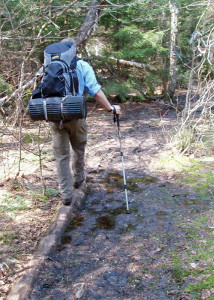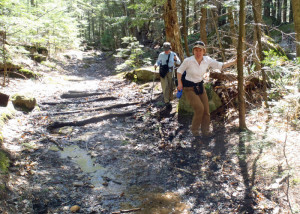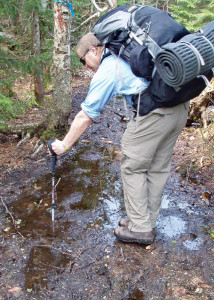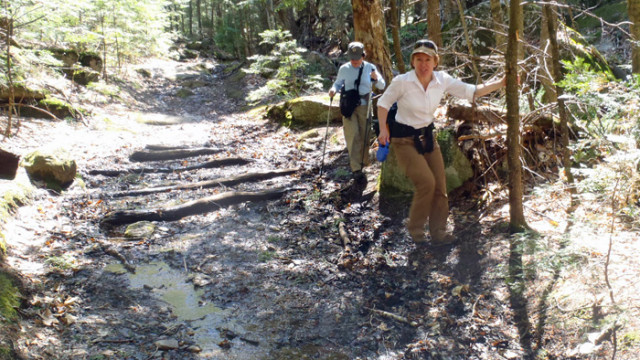
Sometimes it rains a lot in New England, especially in the spring or early summer, but you can get a wet stretch of weather any time from March through December. Basically, you have two choices when it rains long and hard. You can let yourself be kept prisoner, or you can prepare yourself to go out and have fun in it.
There are a few Active Outdoors sports (rock climbing comes to mind) which can’t be done in the rain, but most sports are all still options. Any active water sport like paddling, surfing and windsurfing is pretty much the same in the rain as it is in the sun. Biking in the rain merely requires a good attitude, good rain gear, and some extra caution due to wet roads and reduced visibility.
Hiking Wet Trails: Walk With Caution
Hiking and backpacking in wet conditions, however, requires almost a different mind and skill set than hiking and camping in drier conditions. I’ve written about camping in the rain before. It’s fun and an interesting challenge. But what about hiking? You can don your raingear and a pack cover and stay at least mostly dry, but that’s only part of the story.
Wet trails—even if it’s only from a heavy dew—are a vastly different world than dry trails. The biggest difference: wet makes things slippery. It doesn’t take much water on top of rocks, moss, loose forest duff or fallen leaves to make hiking tougher and more hazardous. This is particularly true in the spring when everything is generally wetter, anyway.
This may sound obvious but the first thing a wet trail forces you to do is slow down and pay attention to each step you take. A slip might be funny/embarrassing. Or it might leave you badly injured or even . . . well, it was most likely a slip on a wet rock that sent Christopher Baillie plunging over the Tuckerman Headwall to his death in July, 2010 . . . You simply have to be more careful hiking when the trail is wet. Trekking poles make a real difference when the trail is wet.
That need for measured caution, in turn, means recalculating how far you can or want to hike in the time you have available. On wet trails, you might only be able to cover three miles in the time it would normally take you to hike five on dry. You don’t want to get caught on the trail after the sun goes down, even if you have a good light with you in your emergency kit. Take trail conditions into account when you plan your hike.
A few years ago, EasternSlopes.com Publisher David Shedd and I decided to see how far we could hike on the Monadnock-Sunapee Greenway in one day. We were hoping to do at least half of the 50+ miles and started up Sunapee in the dark. We made good time to the summit, but just before sunrise a very heavy dew settled and made the grass, moss and rocks on top of Sunapee very slick. That forced us to slow to about half our normal pace. Even at the slower pace, watching our footing on every step was both challenging and tiring. The wet conditions were temporary; everything dried out a couple of hours after the sun rose, but we could have hiked more miles more easily had the trail been perfectly dry. But still, we were out hiking and having fun instead of staying home wishing things were different.

Hiking Wet Trails: Treat Trails With Respect
In the spring, when trails are really soggy whether it rains or not, the impact of water on your hiking increases by orders of magnitude. Simply put, you can do real damage to the trails you love to hike if you aren’t careful.
Some trail maintainers, notably the Green Mountain Club which maintains the Long Trail in Vermont, strongly urge hikers to stay off their hiking trails during the mud season of spring. You can’t blame them. Each step on a soggy trail can set the stage for erosion and other trail damage that they have to fix.
On the other hand, it’s possible to hike in the spring mud season without doing much, if any, damage. But you have to be conscientious and willing to stay in the center of the trail, step on rock when you can or directly into water and mud when you can’t. Yes, that often means hiking with wet feet, even if your boots are supposedly waterproof.
Sadly, trying to avoid getting your feet wet by straying off the side of the trail only increases the damage you do with each step. Some popular hiking trails are 20 feet wide in spots. That’s because people have tried to avoid stepping in puddles and mudholes, walk on the sides of the trail preparing the soil there for erosion. The mudhole expands and the trail just gets wider and wider.

It’s up to each of us to minimize our impact every time we hike. In other words, if you are going to go out hiking in the spring, especially in the rain, be prepared, at least, to get your feet wet. Wet boots may not be fun, but hiking with wet feet is definitely better than staying home!
Hiking Wet Trails: Wet Feet Or Not?
Choosing footgear is the real conundrum when hiking wet trails. Most people think they need waterproof boots. Some hikers just figure their feet are going to get wet anyway and choose breathable, non-waterproof boots that dry quickly. Personally, I don’t think the choice of waterproof or not is nearly as important as having a bootsole with lots of traction. When the weather’s warm, I’d rather have wet feet than slip with every step.
If it’s cold, I’ll try to keep my feet dry, often using waterproof socks. My favorites are knee-high Canadian Army issue which I wear over my cushioning hiking socks inside my boots. They weigh nothing, help keep your feet dry whether your boots are waterproof or not, give you the ability to walk through shallow puddles and small streams with dry feet when necessary.


